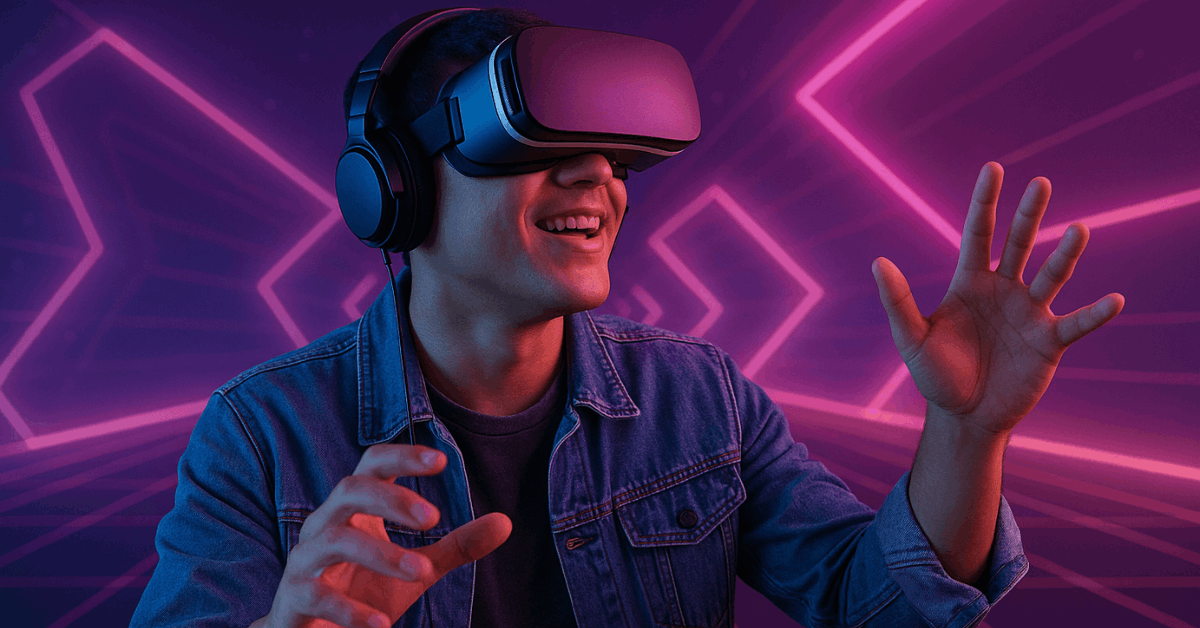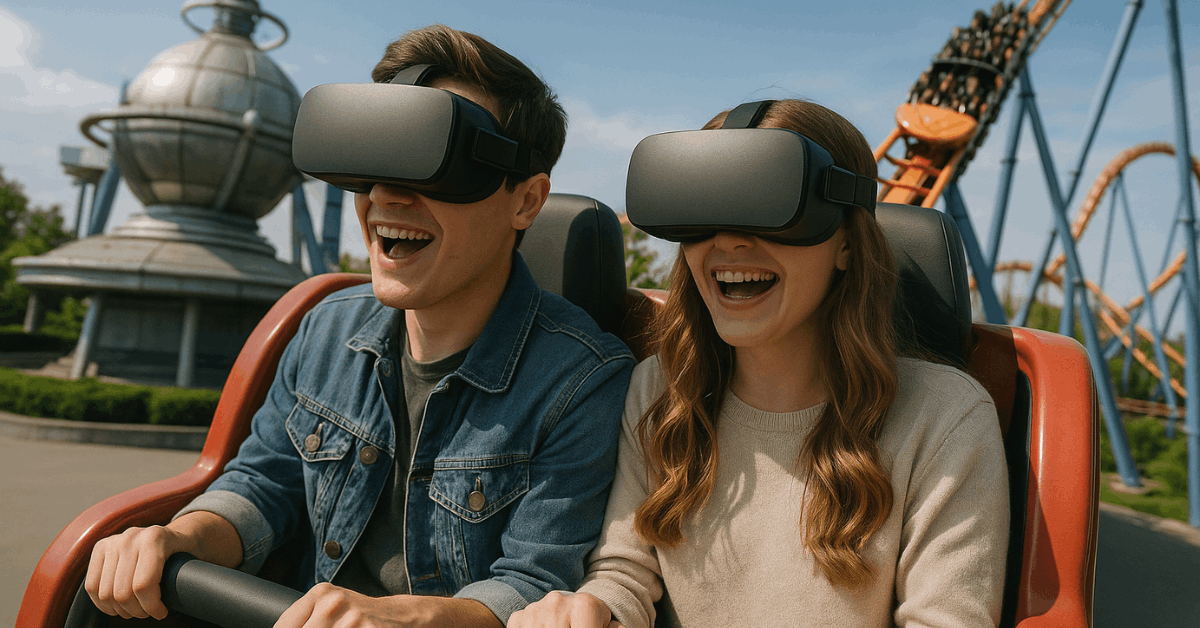Virtual Reality (VR) is rapidly transforming how people engage with digital worlds. This immersive technology is no longer a futuristic idea—it’s becoming part of everyday gaming and entertainment.
The market for VR devices is expanding fast, fueled by innovation and demand. In this article, you’ll learn how VR works, how it changes your experience, and where it’s headed.
What is Virtual Reality Technology?
Virtual reality is the foundation of immersive experiences in modern tech. To understand its future, you need to grasp how it works today.

Basic Definition and How It Works
Virtual reality is a digital simulation that replaces your surroundings with a virtual environment. You interact with it using VR headsets, motion controllers, and sometimes gloves or sensors.
This technology relies on real-time rendering, spatial sound, and tracking to create full immersion. Unlike AR, which adds digital elements to the real world, VR replaces it entirely.
Key Devices and Platforms
Several platforms are leading this space. The Meta Quest series, HTC Vive, and PlayStation VR are popular options.
They differ in terms of power, portability, and content libraries. You can use them for games, movies, and even social events.
How VR is Changing Gaming Today?
Gaming is one of the first industries to fully embrace VR. The results are changing how you play and connect with others.
Full Immersion and Presence
VR is transforming how you play games by placing you directly inside the virtual world. It creates a sense of presence, letting you look around, move, and interact naturally.
Full immersion leads to stronger emotional engagement and realism. Games like Beat Saber, Half-Life: Alyx, and Superhot VR show how gameplay can evolve.
Multiplayer VR and Social Gaming
Multiplayer VR adds a social layer to this experience. You can meet friends, play co-op games, or join virtual communities.
VRChat, Rec Room, and Echo VR are platforms where people interact beyond just gameplay. They offer both structured games and casual spaces.
VR in eSports and Competitive Gaming
VR is finding a strong role in eSports and competitive gaming. It brings physicality and immersion to digital battles.
New Type of Competition
VR is opening new doors in competitive gaming. It introduces movement-based games that test physical skill, accuracy, and reflexes.
Titles like Blaston and Onward have dedicated players and teams. The rise of VR eSports adds a new level of competition.
Spectator Experience in VR
Watching games in VR is also growing. You can become a virtual spectator, experiencing events from front-row seats.
This makes tournaments more engaging and accessible. Some platforms now support live viewing in immersive 3D spaces.
How VR is Shaping the Future of Entertainment Beyond Gaming?
Entertainment doesn’t stop with games in virtual reality. You can also watch movies, attend concerts, and join virtual events.
Virtual Cinemas and 360° Movies
VR is not just for gaming. It’s changing how you experience other forms of media like films, concerts, and live events.
Virtual cinemas offer 3D environments where you watch movies on a massive screen. Apps like Bigscreen VR simulate a theater atmosphere at home.
Concerts, Events, and Theater in VR
Live performances and concerts are also entering VR. Platforms like Wave and Horizon Venues host virtual music events.
You can attend from anywhere and interact with the audience. Some experiences are recorded in 360 degrees for replay.
VR and the Rise of the Metaverse
The metaverse is becoming a shared digital universe powered by VR. It’s changing how you interact, create, and socialize online.
Entertainment Inside the Metaverse
The concept of the metaverse ties closely with VR. These are persistent virtual worlds where users socialize, play, and work.
You can own digital items and build custom spaces. Platforms like Meta Horizon Worlds and Decentraland are leading the trend.
Custom Avatars and Personalization
Avatar personalization is a major part of this shift. You can customize how you appear in VR using clothes, accessories, and facial features.
Many users spend real money on cosmetic upgrades. This deepens your connection to the digital space.
Emerging Technologies That Power VR
Several innovations are pushing VR beyond its current limits. These tools aim to improve realism, comfort, and performance.
Eye Tracking and Hand Tracking
Several technologies are enhancing VR immersion. Eye tracking allows headsets to detect where you’re looking and respond instantly.
This improves interface interaction and reduces motion sickness. Hand tracking replaces controllers for more natural use.
Haptic Feedback and Full-Body Suits
Haptic feedback is advancing quickly. Devices like the bHaptics vest or Teslasuit simulate touch and impact.
You feel vibrations, force, and temperature changes in the game. This expands how your body responds to digital events.
Advanced Graphics and Cloud Streaming
Graphics quality also continues to improve. Cloud rendering allows small headsets to run high-end visuals remotely.
This reduces device cost and weight while keeping performance high. It’s key for mobile and standalone VR.
The Future Outlook for VR in Gaming and Entertainment
VR is evolving quickly and becoming easier to adopt. The next few years will bring smarter features and broader usage.
More Affordable and Portable Devices
VR devices will continue to improve and become more affordable. New models like Meta Quest 3 aim to be lighter, faster, and more comfortable.
Apple’s entry into the VR market is also expected to raise standards. This will encourage more adoption.
AI Integration for Smarter NPCs and Storytelling
Artificial Intelligence will play a bigger role in VR. Smarter NPCs and adaptive game worlds will react to your choices in real time. AI-generated narratives could change how stories are delivered.
Cross-Platform and Hybrid Experiences
Expect more mixed-reality integration. Some games will blend real and virtual elements. Devices will support both VR and AR features. Cross-platform play will also improve.
Key Areas Where VR Will Expand in Entertainment
VR isn’t limited to games and social spaces. It’s set to enhance many parts of the entertainment world.
Music and Performing Arts
VR is likely to reach more types of media soon. Virtual studios, jam sessions, and collaborative concerts are becoming common. Artists can perform in front of global audiences. This model changes how people attend events.
Sports Simulation and Training
Sports teams are using VR for simulation and training. It helps with replay analysis and practicing specific skills.
Real-time scenarios can be recreated in a controlled space. This reduces physical strain while maintaining engagement.
Interactive Documentaries and Education
Interactive documentaries let you explore stories firsthand. VR makes it possible to walk through historical events or scientific simulations. It turns passive learning into immersive exploration. This boosts retention and curiosity.
Theme Park Partnerships
Theme parks are also testing VR integration. Rides become more dynamic when paired with headsets.

Universal and Disney are experimenting with hybrid attractions. This trend could change family entertainment.
Conclusion: Step Into the Future of VR Entertainment
Virtual reality is already changing the way you interact with games and entertainment. It gives you immersive, social, and dynamic experiences that traditional screens can’t offer.
As hardware improves and content grows, VR will become more accessible and mainstream. Now is a good time to explore how this technology fits into your world.



